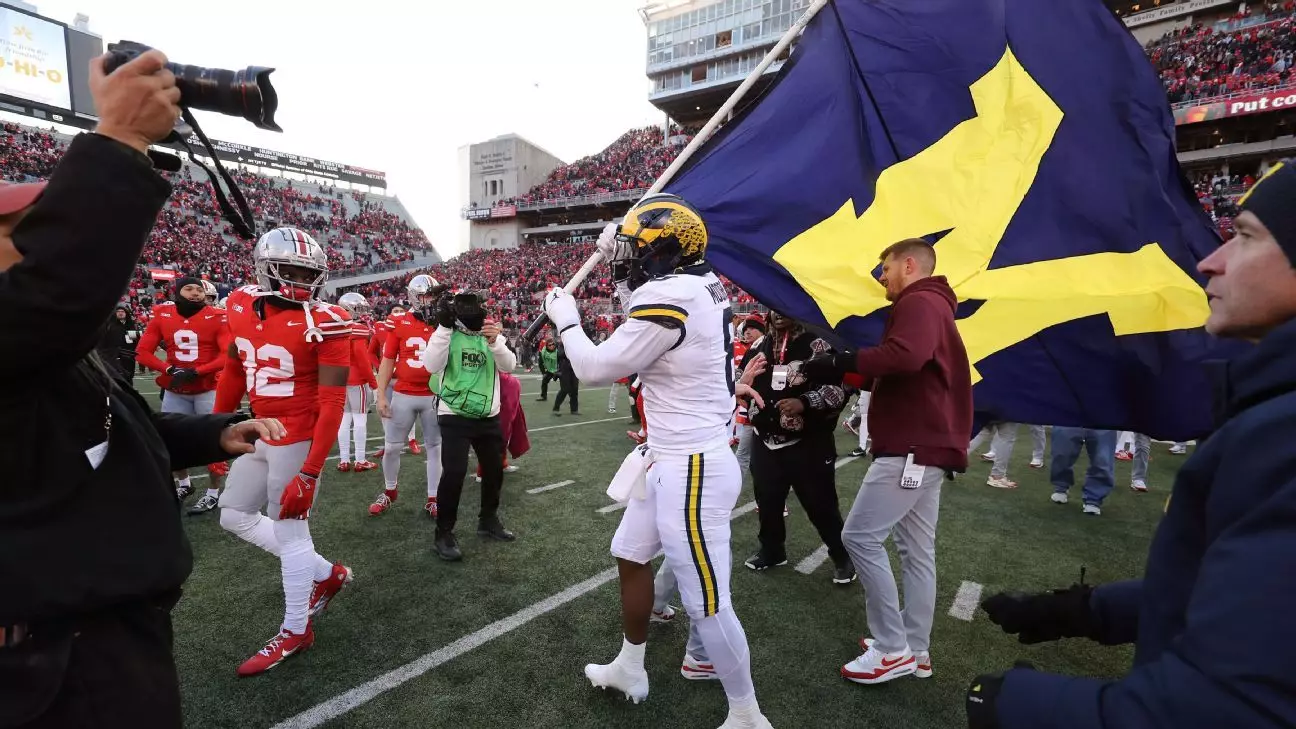In the world of college football, few rivalries ignite as much passion as that between the Michigan Wolverines and the Ohio State Buckeyes. Yet, this bitter rivalry reached a boiling point when the Wolverines celebrated a hard-fought 13-10 victory over the second-ranked Buckeyes in a scene that disrupted what should have been a moment of triumph. Following the game, Michigan’s players planted their flag on Ohio State’s sacred midfield logo, The Horseshoe, an act that stirred animosity and led to an explosive brawl. This incident was not merely a display of team spirit gone awry; it underscored deep-rooted tensions that permeate college sports.
What escalated as an act of celebration transitioned rapidly into chaos. As Michigan players celebrated on the field, emotions flared, resulting in physical altercations between players and coaches from both teams. Such behavior not only diminishes the integrity of the sport but raises essential questions about conduct during high-stakes games.
The Wolverines entered the game as 20.5-point underdogs, which added another layer of intensity to the competition. Despite the odds, Michigan emerged victorious, marking their fourth consecutive win over Ohio State. This upset victory seemed to ignite a cascade of emotions, particularly when the Wolverines’ players chose to mark their triumph by planting their flag. Ohio State head coach Ryan Day expressed the sentiment of many when he stated that pride was at stake; a team’s turf is not merely a physical space but a symbol of dominance and historical superiority in a rivalry that thrives on honor and respect.
In moments of victory, players often grapple with how to manage their adrenaline-fueled emotions. Sherrone Moore, Michigan’s coach, reflected on this chaotic scene when he acknowledged the emotional investment from both sides. His comments hint at a prevalent issue within collegiate sports: managing emotions in high-pressure scenarios remains a challenge for athletes. Rivalry games undoubtedly heighten feelings of pride and aggression, but it is the responsibility of coaches and players to channel those emotions positively.
The aftermath of the brawl had serious repercussions, as police were compelled to intervene with pepper spray to diffuse the situation. Per reports, multiple officers from various law enforcement agencies were on hand, indicating the seriousness of the fallout from what could have spiraled dangerously out of control. The injuries sustained by both players and officers highlight the physicality that crept into a post-game celebration and serves as a cautionary tale for athletes about the potential consequences of their actions.
Moreover, the incident raised alarms regarding the influence of competition on young athletes. As Kalel Mullings stated, emotional responses to losing should never translate into violence. His comments reflect a broader perspective on sportsmanship and the ongoing responsibility athletes carry as representatives of their institutions. Losing gracefully should be just as celebrated as winning; however, the brawl echoed a troubling narrative in which winners and losers fail to appreciate the spirit of the game.
This incident calls into question the traditions and rituals surrounding rivalry celebrations. While flag planting has been a historical component of many sports, its implications and timing alongside victories require scrutiny. The blend of celebration and provocation leaves little room for understanding and could easily plunge into volatile situations—especially in atmospheres charged with strong rival sentiments.
As colleges and athletic programs reflect on such incidents, they must prioritize education surrounding ethical competition and emotional management. Aptly navigating the thin line between jubilation and hostility will define future athletic behavior and is crucial in upholding the sport’s integrity.
Moving forward, both Michigan and Ohio State must reassess how they handle the intricacies of their rivalry. Rivalries are meant to foster competition and camaraderie while respecting the essence of the sporting spirit. By prioritizing respect and integrity over aggression, these storied programs have a golden opportunity to redefine what it means to compete and win in college football.
The lessons learned from the chaotic aftermath of this rivalry game have the potential to influence future encounters and set a precedent for how athletic rivalries should be experienced—through respect, emotional intelligence, and a shared love for the game. Only then can we hope to witness rivalries that honor both the competitors and the spirit of college athletics.


Leave a Reply